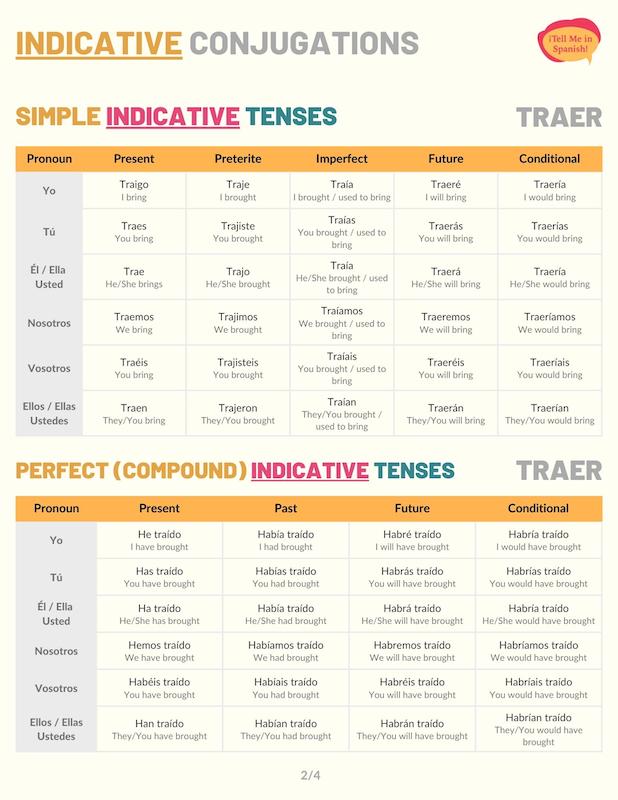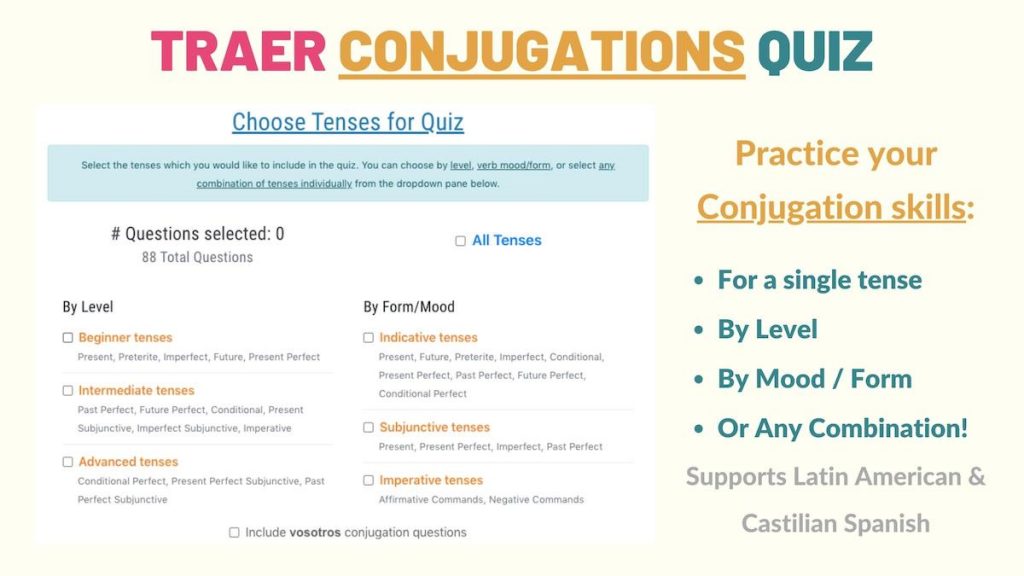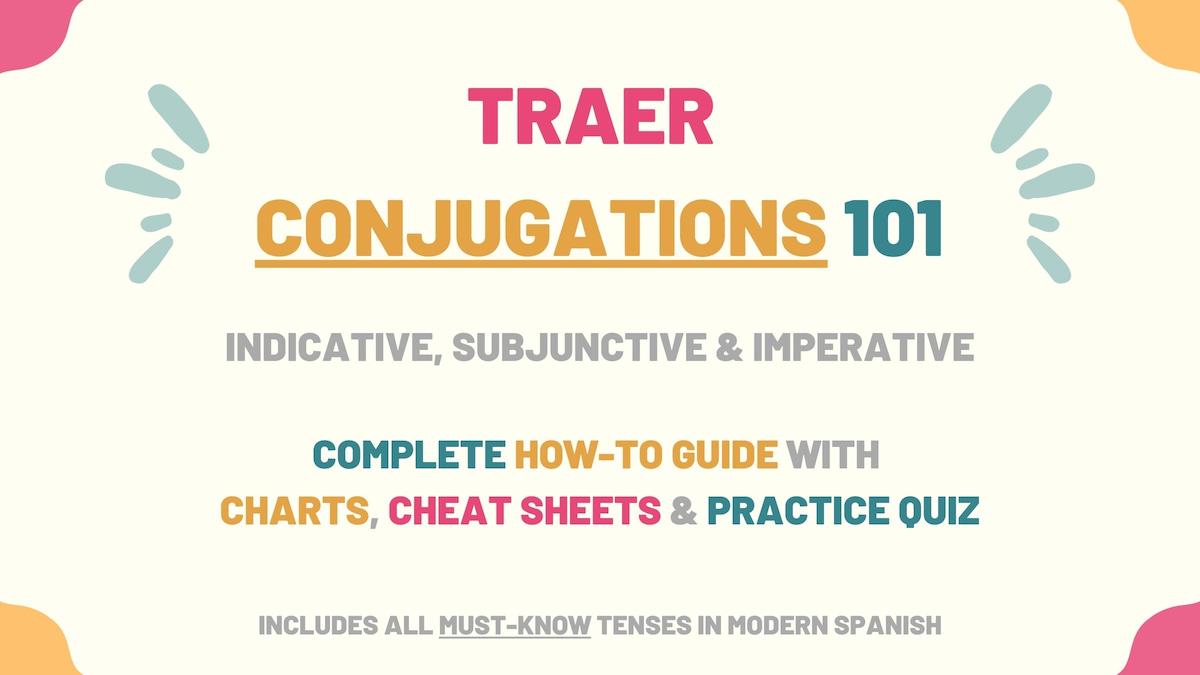Traer is an irregular -ER verb in Spanish. Because it’s also common for your conversations, in this article, we’ll review the most common traer conjugation patterns. Here’s a summary of what you’ll learn:
- Traer Overview
- Indicative Tenses of Traer Conjugations
- Subjunctive Tenses of Traer Conjugations
- Imperative (Commands) of Traer Conjugations
- Uses & Examples
- Download Traer Conjugation Tables & Uses Cheat sheets
- Traer Conjugation Practice Quiz
Overview of Traer
| Verb Characteristic | Property |
|---|---|
| Verb Type | -ER |
| Irregular | Yes |
| Infinitive | Traer |
| Gerund (Present Participle) Form | Trayendo |
| Past Participle Form | Traído |
| Synonyms | Usar, vestirse, llevar, transportar, tener. |
Irregularities:
- Present: traig only for ‘yo’.
- Preterite: traj for all subject pronouns.
- Present subjunctive: traig for all subject pronouns.
- Imperfect Subjunctive: traje for all subject pronouns.
- Affirmative imperative: traig for ‘usted’ and ‘ustedes’.
- Negative imperative: traig for all subject pronouns.
This verb means ‘to bring’, ‘to carry’, ‘to fetch’, ‘to have’, among other meanings. The traer conjugation charts only use one translation for organization purposes. You can learn more about the different applications of this verb in the Uses & Meanings section.
Indicative Conjugations of Traer
Present tense
Traer’s conjugation in the present tense is irregular for the subject pronoun ‘yo’. For this pronoun, we must use the stem traig. These traer conjugations are used to talk about what someone brings or carries. For example: No traigo cambio.
| Person | Conjugation | Translation |
|---|---|---|
| Yo | Traigo | I bring |
| Tú | Traes | You bring |
| Él / Ella Usted | Trae | He/She brings You (formal) bring |
| Nosotros | Traemos | We bring |
| Vosotros | Traéis | You bring |
| Ellos / Ellas Ustedes | Traen | They bring You (plural) bring |
Preterite tense
Traer preterite conjugations are irregular. To form this tense, we must use the stem traj for all subject pronouns and the preterite irregular endings. With these past tense conjugations, traer expresses that someone brought something. For example: ¿Trajeron leche?
| Person | Conjugation | Translation |
|---|---|---|
| Yo | Traje | I brought |
| Tú | Trajiste | You brought |
| Él / Ella Usted | Trajo | He/She brought You (formal) brought |
| Nosotros | Trajimos | We brought |
| Vosotros | Trajisteis | You brought |
| Ellos / Ellas Ustedes | Trajeron | They brought You (plural) brought |
Imperfect tense
In this tense, this verb is regular. Use traer imperfect conjugations to explain what someone used to bring or carry for a long period of time in the past. For instance: Mi papá siempre nos traía dulces.
| Person | Conjugation | Translation |
|---|---|---|
| Yo | Traía | I brought I used to bring |
| Tú | Traías | You brought You used to bring |
| Él / Ella Usted | Traía | He/She brought He/She used to bring You (formal) brought You (formal) used to bring |
| Nosotros | Traíamos | We brought We used to |
| Vosotros | Traíais | You brought You used to bring |
| Ellos / Ellas Ustedes | Traían | They brought They used to bring You (plural) brought You (plural) used to bring |
Near future
Use ir’s present indicative conjugations + a + traer to create the immediate future in Spanish. As its name suggests, this tense conveys that a person is going to bring something in the immediate future. For example: Vamos a traer más comida.
| Person | Conjugation | Translation |
|---|---|---|
| Yo | Voy a traer | I’m going to bring |
| Tú | Vas a traer | You’re going to bring |
| Él / Ella Usted | Va a traer | He/She is going to bring You (formal) are going to bring |
| Nosotros | Vamos a traer | We’re going to bring |
| Vosotros | Vais a traer | You’re going to bring |
| Ellos / Ellas Ustedes | Van a traer | They’re going to bring You (plural) are going to bring |
Future simple tense
The following traer conjugation chart shows that this verb is regular when conjugated to the future simple tense in Spanish. Use this tense to say that someone will bring or carry something. You can also use these forms to ask politely if people are carrying something.
For example: ¿Traerás otra pluma?
| Person | Conjugation | Translation |
|---|---|---|
| Yo | Traeré | I will bring |
| Tú | Traerás | You will bring |
| Él / Ella Usted | Traerá | He/She will bring You (formal) will bring |
| Nosotros | Traeremos | We will bring |
| Vosotros | Traeréis | You (formal) will bring |
| Ellos / Ellas Ustedes | Traerán | They will bring You (plural) will bring |
Conditional tense
When conjugated to the conditional tense, traer expresses that someone would bring something. For example: Mi papá dijo que él traería la cena.
| Person | Conjugation | Translation |
|---|---|---|
| Yo | Traería | I would bring |
| Tú | Traerías | You would bring |
| Él / Ella Usted | Traería | He/She would bring You (formal) would bring |
| Nosotros | Traeríamos | We would bring |
| Vosotros | Traeríais | You would bring |
| Ellos / Ellas Ustedes | Traerían | They would bring You (plural) would bring |
Present perfect tense
In the Spanish present perfect tense, traer communicates whether someone has brought something or not. To build this perfect tense, use haber in present form + traído (past participle). For example: ¿Quién no ha traído su aplicación?
| Person | Conjugation | Translation |
|---|---|---|
| Yo | He traído | I have brought |
| Tú | Has traído | You have brought |
| Él / Ella Usted | Ha traído | He/She has brought You (formal) have brought |
| Nosotros | Hemos traído | We have brought |
| Vosotros | Habéis traído | You have brought |
| Ellos / Ellas Ustedes | Han traído | They have brought You (plural) have brought |
Take Note: Past participles are accented in Spanish when the root of the verb ends in a vowel.
Past perfect
Traer past perfect conjugations convey that someone had or hadn’t brought something before a past moment or action. The elements you must use to conjugate this tense are haber’s imperfect conjugations + past participle verb (traído).
For example: ¿Ya habías traído a tu novio?
| Person | Conjugation | Translation |
|---|---|---|
| Yo | Había traído | I had brought |
| Tú | Habías traído | You had brought |
| Él / Ella Usted | Había traído | He/She had brought You (formal) had brought |
| Nosotros | Habíamos traído | We had brought |
| Vosotros | Habíais traído | You had brought |
| Ellos / Ellas Ustedes | Habían traído | They had brought You (plural) had brought |
Future perfect
Conjugate traer to the future perfect tense to say that someone will have brought something by or before a future point in time. For example: Para el lunes, todos habrán traído su proyecto.
| Person | Conjugation | Translation |
|---|---|---|
| Yo | Habré traído | I will have brought |
| Tú | Habrás traído | You will have brought |
| Él / Ella Usted | Habrá traído | He/She will have brought You (formal) will have brought |
| Nosotros | Habremos traído | We will have brought |
| Vosotros | Habréis traído | You will have brought |
| Ellos / Ellas Ustedes | Habrán traído | They will have brought You (plural) will have brought |
Conditional perfect
In Spanish, we conjugate traer to the conditional perfect tense to say that a person would have brought something or someone else. For example: Habríamos traído más comida si hubiéramos sabido que estaban aquí.
| Person | Conjugation | Translation |
|---|---|---|
| Yo | Habría traído | I would have brought |
| Tú | Habrías traído | You would have brought |
| Él / Ella Usted | Habría traído | He/She would have brought You (formal) would have brought |
| Nosotros | Habríamos traído | We would have brought |
| Vosotros | Habríais traído | You would have brought |
| Ellos / Ellas Ustedes | Habrían traído | They would have brought You (plural) would have brought |
Progressive tenses
The estar conjugations + trayendo (present participle) allow you to form progressive tenses in Spanish. These traer conjugations emphasize that someone is bringing something at the moment of speaking. Apenas estamos trayendo nuestras cosas.
| Progressive Tense | Formula | Translation Example |
|---|---|---|
| Present | Estar (present) + trayendo | I am bringing |
| Preterite | Estar (preterite) + trayendo | You were bringing |
| Imperfect | Estar (imperfect) + trayendo | He was bringing |
| Future | Estar (future) + trayendo | We will be bringing |
| Conditional | Estar (conditional) + trayendo | They would be bringing |
Take Note: In Spanish, we use the present participle ending yendo only when the verb’s root ends in a vowel. Leer and oír are examples of verbs that also follow this rule.
Traer Subjunctive Conjugations
In Spanish, you can use the subjunctive mood to communicate requests, suggestions, doubts, expectations, hypothetical situations, or desires someone has. In the coming sections, we’ll go over traer conjugation charts for the key subjunctive tenses.
Present subjunctive
The traer subjunctive conjugations are irregular. To form this tense, we must use the stem traig. Use these traer conjugations to request, hope, or advise someone to bring something. For example: No quiero que traigan a sus amigos a mi casa.
| Person | Conjugation | Translation |
|---|---|---|
| Yo | Traiga | I bring |
| Tú | Traigas | You bring |
| Él / Ella Usted | Traiga | He/She brings You (formal) bring |
| Nosotros | Traigamos | We bring |
| Vosotros | Traigáis | You bring |
| Ellos / Ellas Ustedes | Traigan | They bring You (plural) bring |
Present perfect subjunctive
The present perfect subjunctive in Spanish is formed with haber subjunctive conjugations + traído. This tense allows you to wish that someone has brought something. For instance: Ojalá que Cecilia no haya traído a su novio.
| Person | Conjugation | Translation |
|---|---|---|
| Yo | Haya traído | I have brought |
| Tú | Hayas traído | You have brought |
| Él / Ella Usted | Haya traído | He/She has brought You (formal) have brought |
| Nosotros | Hayamos traído | We have brought |
| Vosotros | Hayáis traído | You have brought |
| Ellos / Ellas Ustedes | Hayan traído | They have brought You (plural) have brought |
Imperfect subjunctive
To form the imperfect subjunctive in Spanish, use the irregular stem traje. These traer subjunctive conjugations refer to past desires, demands, or requests you had about someone bringing something. For example: Les dije que no trajeran nada.
Latin American and Castilian Spanish use different conjugation models for the imperfect subjunctive tense:
Latin American Spanish version
| Person | Conjugation | Translation |
|---|---|---|
| Yo | Trajera | I brought |
| Tú | Trajeras | You brought |
| Él / Ella Usted | Trajera | He/She brought You (formal) brought |
| Nosotros | Trajéramos | We brought |
| Ellos / Ellas Ustedes | Trajeran | They brought You (plural) brought |
Note: The table above doesn’t include the traer conjugation for vosotros because this pronoun is not used in Latin American Spanish.
Castilian Spanish version
| Person | Conjugation | Translation |
|---|---|---|
| Yo | Trajese | I brought |
| Tú | Trajeses | You brought |
| Él / Ella Usted | Trajese | He/She brought You (formal) brought |
| Nosotros | Trajésemos | We brought |
| Vosotros | Trajeseis | You brought |
| Ellos / Ellas Ustedes | Trajesen | They brought You (plural) brought |
Past perfect subjunctive
If you want to express that someone would have brought something as long as a past condition had occurred, you must conjugate this verb to the past perfect subjunctive. These traer conjugations also show regret for having brought something or not. ¡Hubieran traído más leche!
| Person | Conjugation | Translation |
|---|---|---|
| Yo | Hubiera traído | I had brought |
| Tú | Hubieras traído | You had brought |
| Él / Ella Usted | Hubiera traído | He/She had brought You (formal) had brought |
| Nosotros | Hubiéramos traído | We had brought |
| Vosotros | Hubierais traído | You had brought |
| Ellos / Ellas Ustedes | Hubieran traído | They had brought You (plural) had brought |
Traer Imperative Conjugations
A verb conjugated to imperative mood in Spanish is used to command people to perform or not perform an action.
Affirmative commands
Traer conjugated to the affirmative imperative allows you to order someone to bring something. Notice that these conjugations use the irregular stem traig for the subject pronouns ‘usted’ and ‘ustedes’. Traigan esas cajas, por favor.
| Person | Conjugation | Translation |
|---|---|---|
| Tú | Trae | Bring |
| Usted | Traiga | Bring |
| Vosotros | Traed | Bring |
| Ustedes | Traigan | Bring |
Negative commands
The negative imperative conjugations of traer use the stem traig for all subject pronouns. When using these forms, you’re ordering people not to bring something or someone to a place. No traigas más galletas, tenemos muchas.
| Person | Conjugation | Translation |
|---|---|---|
| Tú | No traigas | Don’t bring |
| Usted | No traiga | Don’t bring |
| Vosotros | No traigáis | Don’t bring |
| Ustedes | No traigan | Don’t bring |
Meanings of Traer & Examples
So far, we’ve learned how to conjugate traer in Spanish. In this section, we’ll review some examples of how to use this verb. Depending on the type or words used and context, traer can mean to:
- Bring or fetch
- Have or carry
- Be up to (with pronominal pronouns)
[Traer conjugated] + [complement]
Tráela, Ruffus.
Fetch it, Ruffus.
¿Qué se traen ustedes dos?
What are you two up to?
Yo siempre traigo dinero extra.
I always carry extra money.
Les traje estos chocolates suizos.
I brought you these Swiss chocolates.
Take Note: Traer uses direct objects when saying that you’re fetching or bringing something. However, if you’re bringing something to someone, u must use indirect object pronouns.
Download Traer Conjugation Charts & Uses Cheat sheet

Traer is an important and very common -ER verb in Spanish. It’s also an irregular verb, since it has its own unique patterns. Feel free to download the traer PDF cheat sheet containing all the conjugation charts as well as its meanings and example sentences. It could help you as a quick reference when applying it to your Spanish conversations.
Practice Quiz: Traer Conjugation

You’ve now seen how to conjugate traer in all of the essential Spanish tenses. The key to mastering irregular verbs like this one is by putting it to use. You can start achieving that and become more confident using it by taking the traer conjugation practice quiz.





